Introduction
It looks like we know almost everything about electric current. Electric motors working very close to what expected, keeps us under the impression that everything is quite right with the theory. In fact, almost everything we know about electric current is not true and I am going to demonstrate it here. I will not even use the fact that the origin of electric charge is unknown. Aristotle once said that “we possess scientific knowledge of a thing only when we know its cause”. Let's start.
Definition
Today's science defines electric current as a stream of charged particles. Is it really so?
Magnetic Field
It is well known fact that electric current creates magnetic field around it.
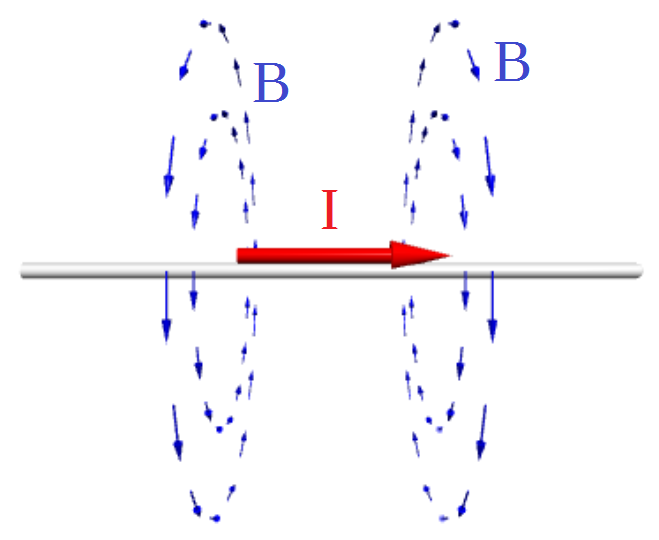
Fig.1 Magnetic Field of Electric Current
Magnetic field was created around wire by moving electrons, according to Biot-Savart law.
The problem we have here is Galilean invariance, which states that the laws of physics are the same in all inertial frames. According to this claim, any observer moving along the wire should be able to detect magnetic field around wire.
We are free to set inertial frame moving with the same velocity as electrons do. Charged particle at rest do not create any magnetic field and magnetic field should not exist in such frame.
Modern science solved above problem in usual manner. Yes, the electrons are not moving at all, but the positively charged crystal lattice of the metal is moving now in the opposite direction, creating absolutely same magnetic field. Voila, the problem was solved?
Electronic Beam
No, the problem just began.
Imagine beam of electrons, electronic microscope for example. Very good example from the past is Cathode Ray Tube (CRT). Electronic beam, which creates image on the face of the tube due to electroluminescence, controlled by electric field between deflector plates.
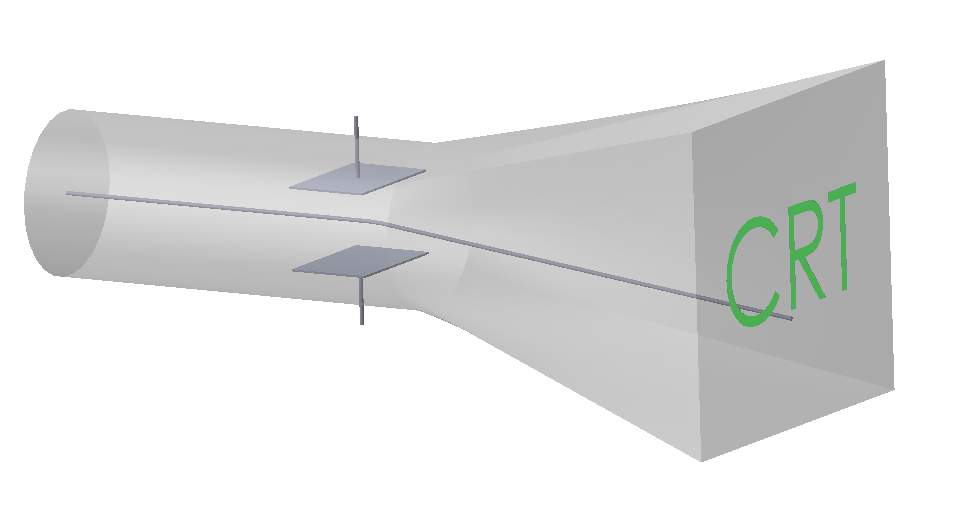
Fig.2 Cathode Ray Tube
We do exactly same trick – switch to reference frame moving along with the electrons in the beam. According to the theory, magnetic field created by moving electrons should disappear, but this time we don't have anything like metal lattice.
According to current theory, the magnetic field of electronic beam should not exist. Is electric current really a charge in motion?
Free Electrons
As everybody knows, the metals are filled with free electrons, positively charged atomic lattice immerse in the sea of free electrons. The phenomenon of electrical resistance connected very closely to these free electrons.
Physics textbooks telling us that the cause of electric resistance is colliding of free electrons with positive ionic lattice.
Free electrons in the metals are very similar to ideal gas. We could even find mean path of thermal electrons in textbooks. Mean path of electrons in Silver, for example, is about 120 interatomic distances. On its way each electron hits atom 120 times and then turns and hit again. Why such collision does not produce energy dissipation? Why the piece of metal is not heated by random movement of free electrons? Maybe the electrons are not that free?
Why?
Why does electric current flows? The answer you could find in scientific books is simple – because of potential difference. There are several objection on such definition.
First of all, consider the following example – we have battery and light bulb connected with 10 meters of wires. You connect the battery and will light appeared momentarily? Absolutely not, all science books gives you propagation speed close to the speed of light. That makes delay between closure of circuit and actual light around 10/3e8 = 33 nanoseconds. But potential difference appeared momentarily along the whole wire, according to physics. Why this potential difference not moving all electrons in wire at once, momentarily? There are no formulas for potential difference propagation.
Here is another problem – connect two terminals of the 12 volts battery with one meter of wire. The electric field between ends of the wire will be 12 volts per meter. Now place same piece of wire somewhere vertically. As we know, the electric field in the vicinity of Earth’s surface is about 100 volts per meter. The potential difference between two ends of wire will be 100 volts! Will electric current flow in the wire? I doubt it.
Definitely potential difference is not the cause of electric current. At least not the only cause. Maybe potential difference exists because of electric current?
Speed
What is the speed of the propagation of electric current? Consider very simple experiment – battery, wires and light bulb or some electric load. We close the switch and the light will be on after some delay. What is the value of this delay?
Interesting question – if we have two variants of the circuitry, one with the switch close to the battery and second with switch close to the bulb. Are bulb turn on delays the same for both circuitry?
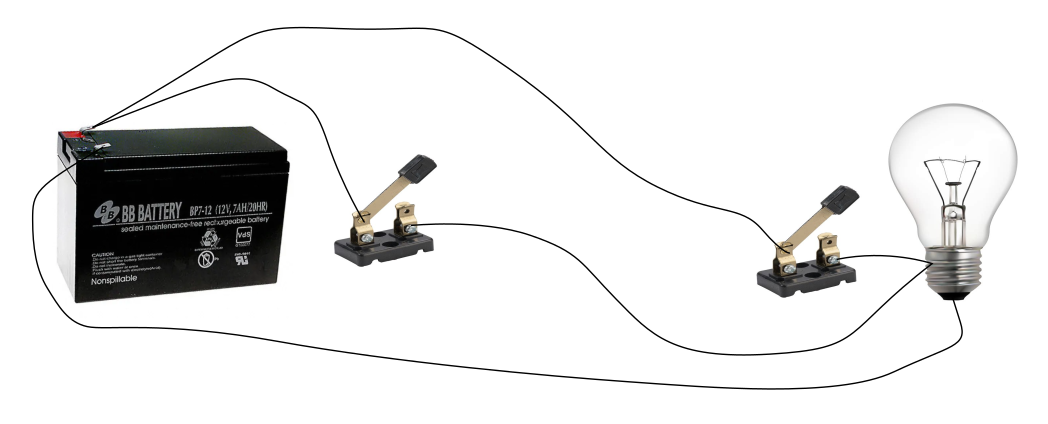
Fig.3 Which switch is “faster”?
If one tries to find in the books how fast electricity goes, he will be disappointed. Instead answering the question, science offer you a bunch of formulas for electromagnetic wave propagation either in dielectric or in the conductor. The formulas for speed always contains frequency. In above circuitry with battery and the bulb there is no frequency!
First Try
There are two basic approach in physics for propagation of electric current. First idea is the following: electrons are standing in the wire like balls inside the pipe. When circuitry closed, the battery starts to push electrons along the wire. First electron pushing the next one and so on and so forth.

Fig.4 Electron “Pushing”
First experiment purpose was to measure delay of electrical signal in the long wire.
A coil was made by winding 100 meters of wire. The inductance of such coil is big enough to ruin our measurements. Inductor will limit the current ramp and the output signal will be distorted. Below are typical signal waveform after inductor:

Fig.5 Inductance response
Quite difficult for delay time measurement, isn't it?
In order to eliminate inductive distortion, the second half of the coil was winded in the direction opposite to the first half. Inductance of such coil equals to zero and time delay measurement become much easier. The setup of experiment shown below:
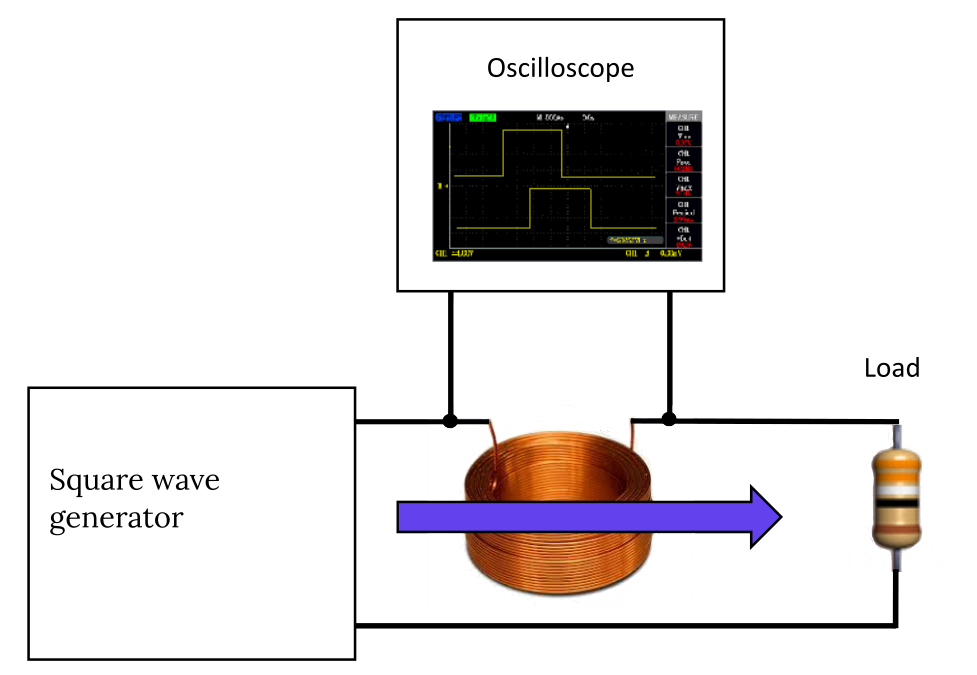
Fig.6 Long wire delay measurement
The result of experiment does not match this expectation, delay is about 3 nanoseconds. Looks like electricity, whatever it is, propagates not in the wires, but between wires, as it shown by blue arrow. Delay of 3 nanoseconds corresponds to approximately one meter of distance which was the actual distance between signal source and resistive load.
Poynting Vector
Electrons in the pipe analogy only learnt in the schools. For university students another version exists – Poynting vector. The idea behind this is not physical, it is just pure mathematics like almost everything else in today's science.
They said that energy not carried by the electrons itself, but instead the energy contained in the electromagnetic fields which electrons created. This energy is not propagates by itself, the mathematical construct called Poynting vector carry the energy.
Poynting vector is cross product of electric and magnetic field. It is quite easy to invent paradoxes associated with field energy. Turn on the switch and the current flows from battery to the bulb. Magnetic field invades the space around wires. Now turn the switch off. Where this energy disappeared? It could not just vanished, the energy should be conserved. Does it goes back to electrons, back to battery, or just simply heated the space? No answers.
Poynting vector is cross product of electric and magnetic field. Let’s try to visualize circuitry with the bulb and battery:
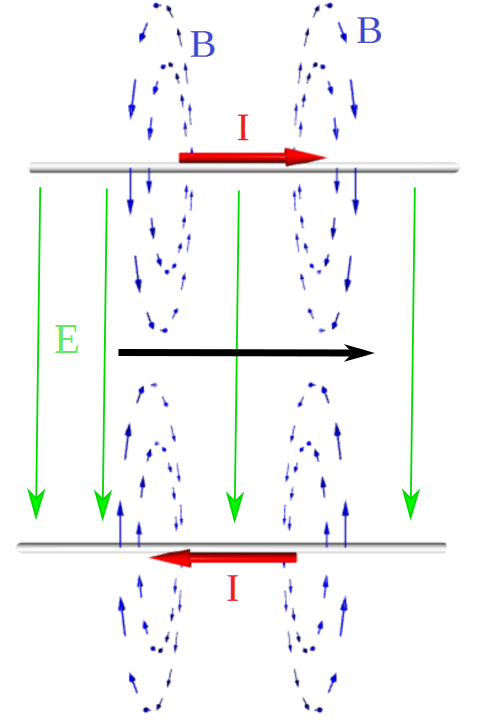
Fig.7 Poynting vector
In the above picture electric current shown in red, magnetic field in blue, electric field in green. Resulting Poynting vector shown in black and directed from battery to the electric load.
Several objections comes to mind right away. Current carrying wire has no electric field and resulting cross product is zero. There are some publication that battery creates surface charges along the wire, but this is just to keep Poynting vector concept alive.
Take a look at electromagnetic crane:

Fig.8 Electromagnetic crane
When magnet activated, it lifts the weight. Potential energy of the weight increased. Definitely we have energy flow – from magnet to weight. There is no electric field and Poynting vector is zero.
I could give free idea for those who believe in Poynting vector tale. Here comes EM drive!
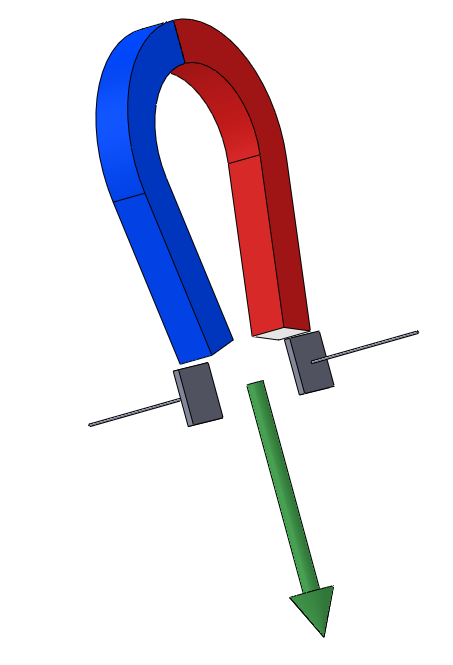
Fig.9 EM drive!
We have permanent magnet and capacitor. Magnetic field of the magnet is perpendicular to electric field of capacitor. Poynting vector is shown in green. If some energy flow away from the system but nothing material escapes, then modern physics should say – photons they are. Photons carry momentum and voila – EM drive was invented.
Second Try
Anyway, the idea behind Poynting vector is that EM field is the energy carrier and the energy flux propagates between wires. The speed of propagation, according to textbooks depend on permittivity of the dielectric media between wires.
$$\large v = {{c} \over {\sqrt{\epsilon \mu }}} \tag{1}$$To check this statement, the following experiment performed – propagation delay of electric signal in two parallel wires was measured. The length of wires was about two meters. The dielectric was air with relative permittivity equals to one.
Measured propagation delay was about 6 nanoseconds which is well within the theory.
The wires were immersed into water. Relative permittivity of the water is about 80, relative permeability is close to one and new delay should be in the range of \(6*\sqrt {80*1} \approx 53\) nanoseconds.
Measured delay was not changed and still in the 6 nanoseconds range.
Does it really depend on dielectric media?
Conclusion
• Electric current is not the motion of charges
• Yes, electric current propagates between wires, not inside wire
• No, electric current not propagates between wires
• What is electric current?